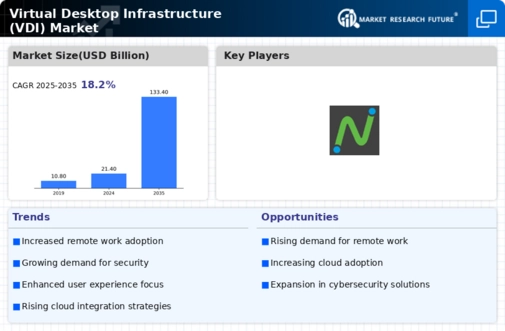Market Share
Virtual Desktop Infrastructure Market Share Analysis
The introduction of Virtual Desktop Infrastructure (VDI) is changing the way we control and manage desktop environments. VDI allows the centralization of desktop control in data centers, offering several advantages. Its adoption in data centers brings increased safety and better control over IT operations. This, in turn, reduces the costs associated with refreshing desktop hardware year after year. Additionally, the advancements in storage and graphics capabilities make VDI an excellent choice for modern data center applications. One key benefit of implementing VDI in data centers is the enhanced safety it provides. By centralizing the control of desktop environments, companies can have a better grip on their IT operations. This centralized approach offers improved security measures, making it harder for unauthorized access or security breaches. This increased safety is crucial in today's digital landscape, where data security is of utmost importance. Moreover, VDI helps in reducing the costs associated with refreshing desktop hardware on a yearly basis. In traditional setups, companies often need to replace or upgrade individual desktop computers to keep up with the latest technologies. This can be a costly and time-consuming process. However, with VDI, the desktop environment is virtualized and managed centrally in data centers. This means that updates or upgrades can be applied to the entire virtual desktop infrastructure at once, saving both time and money. The improvements in storage and graphics capabilities further contribute to making VDI an ideal choice for modern data center applications. The storage capabilities of VDI allow for efficient handling of large amounts of data associated with desktop environments. Additionally, the graphics capabilities ensure a seamless and high-quality user experience, even for graphics-intensive applications. This makes VDI versatile and suitable for a wide range of tasks, from simple office applications to more demanding graphical and multimedia tasks. Looking ahead, the rapid deployment and cost-effectiveness of Virtual Desktop Infrastructure are expected to create significant opportunities in the market. The ability to quickly deploy virtual desktops simplifies the process of setting up new workstations or adapting to changing business needs. This agility is crucial in today's fast-paced business environment, where companies need to be flexible and responsive to market demands. The cost-effectiveness of VDI is another driving factor for its adoption in the data center industry. As mentioned earlier, the centralized management of virtual desktops reduces the overall costs associated with hardware refresh cycles. This includes savings in terms of both time and money. Companies can allocate resources more efficiently, focusing on strategic initiatives rather than routine hardware upgrades. In conclusion, Virtual Desktop Infrastructure (VDI) is reshaping how we control desktop environments by centralizing management in data centers. Its adoption in data centers enhances safety, provides better control over IT operations, and reduces the costs associated with yearly desktop hardware refreshes. The advancements in storage and graphics capabilities make VDI well-suited for modern data center applications. The rapid deployment and cost-effectiveness of VDI are expected to open up significant opportunities in the market, driving its adoption in the data center industry.





Leave a Comment